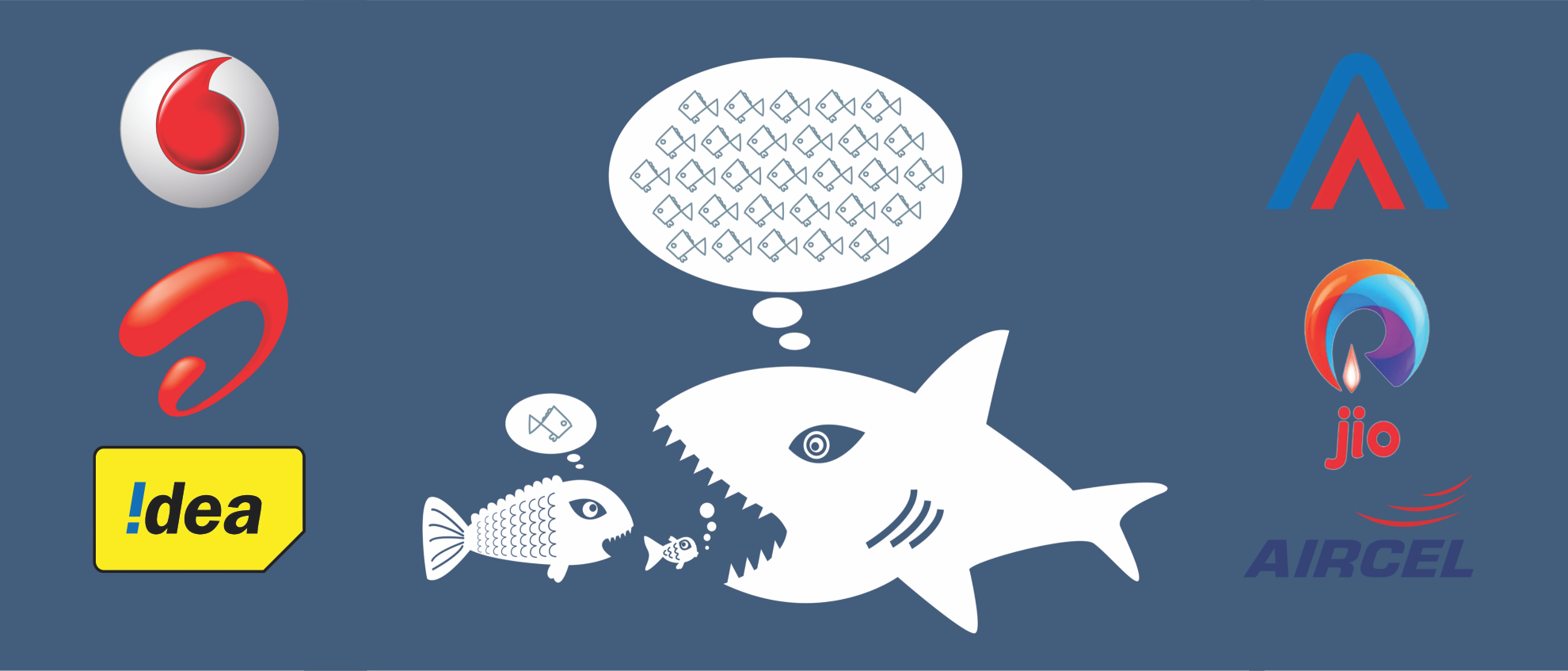For the Chairman of Reliance Industries, Mukesh Ambani, the launch of Jio is his attempt to strike it big in the high-growth Indian telecom industry. The launch will carry forward the dream of roti, kapda, makaan, aur internet to every Indian of Reliance’s founder late Dhirubhai H Ambani, one of the most astute and visionary entrepreneurs our country has ever had. The tariff plan offered by the company – free unlimited voice, no additional charges for roaming, and jaw-dropping internet usage charges – has already set a big paradigm shift on wireless pricing and will benefit consumers across the country.
The predatory pricing offered by the company has already set the ball rolling for merger talks of small players like Tata Teleservices, Reliance Communications (R-Com) and Aircel as it will be difficult for these companies to match Joi’s or even Airtel and Vodafone’s tariff and compete in the industry. Just two weeks after Jio’s launch, the first merger took place between Anil Ambani’s R-Com and Aircel and a few others are in the pipeline. No doubt Jio was a pressing factor in uniting these two companies, but talks were in progress since last year.
The Indian telecom industry is buzzing with activities. With more than one billion mobile phone subscriptions, India’s telecoms market is the world’s second-biggest after China. Telecom is a capital-centric business, and disruption created by Jio’s entry with free voice has shaken up the industry. In order to fight the might of Jio, smaller telcos will need to join their forces and create a power of equal magnitude, something which Aircel and RCom understood well in advance. Idea and Tata are now the players to watch for, along with BSNL to observe how they respond to the challenge of Jio in coming days.
The probability of more consolidation in the telecom industry has risen, a point which was underlined by Sunil Mittal, Chairman of Bharti Airtel who expects just four private operators to remain in business in 24 months from now. It is widely perceived that only Bharti Airtel, Vodafone India, Idea Cellular and Reliance Jio Infocomm would remain in business in 24 months from now post the current round of consolidation. Fitch Ratings, in a report said that the sector should continue to consolidate. It said that about five to six players could emerge from the shakeout. “Unprofitable telcos, such as Telenor and Tata, could exit, given that their businesses will struggle to compete and they are now able to monetise their most valuable assets — their underutilized spectrum, “ the research report said.
Merger of R-Com and Aircel
In the biggest consolidation deal in the telecom sector, R-Com and Maxis Communications Berhad (MCB) of Malaysia, promoters of Aircel will merge their wireless business to form the fourth-largest telecom operator in the country. At present, Reliance Communications is the fourth-largest mobile carrier by subscribers, while Aircel ranks sixth in the market of 10 players led by Bharti Airtel Ltd and Vodafone Group Plc’s Indian unit. Reliance Communications is India’s foremost and truly integrated telecommunications service provider and has a customer base of 107 million, including over 2.6 million individual overseas retail customers. The company has established a pan-India, next-generation integrated (wireless and wireline) convergent (voice, data and video) digital network capable of supporting services across the value chain.
Aircel is one of the country’s leading innovative mobile service providers and is a pan-India 2G operator with 3G spectrum in 13 circles and is credited with the fastest 3G roll out ever in the Indian telecom space.
The merged business with more than 180 million customers will overtake Idea Cellular Ltd in terms of subscription numbers although will still lag it in terms of revenue. The merged company will be one of India’s largest private sector companies, with an asset base of over Rs 65,000 crore and net worth of Rs 35,000 crore. The merged company will have the second-largest holding amongst all operators aggregating 448 MHz across the 850, 900, 1800 and 2100 MHz bands and will enjoy enhanced business continuity through extended validity of spectrum holdings till 2033-35. The combined entity will enjoy substantial benefits of scale driving significant revenue growth, and capex and opex synergies with a Net Present Value (NPV) of Rs 20,000 crore. Both of these companies will invest $570 million each to create a pool of Rs 7,600 crore, which would be used to expand their business and buyout more spectrum. If the merger goes through successfully, the merged entity will have access to Aircel’s top five circles — Assam, UP East, Bihar, Jammu & Kashmir and Gujarat. RCom’s top circles are Bihar, Tamil Nadu and Chennai.
Both RCom and Aircel are reeling under heavy debt, and this merger will give them some room to breathe. As a result of the merger, a new entity would be created, along with a new brand name to sell telecom services. The deal will reduce R-Com’s overall debt by Rs 20,000 crore or over 40% of its total debt and Aircel’s debt will reduce by Rs 4,000 crore. Since acquiring Aircel in 2006, MCB has invested in excess of Rs 35,000 crore in Aircel, making this one of the largest foreign investments into India, not only in the telecom industry but across all sectors.
There is no clarity on the leadership or management team yet. However, Industry buzz is that upon completion, the merged entity will also rope in a third partner by diluting about 25%equity to raise around Rs 6,000 crore. Talks have already been in progress with Russia’s Sistema, which already holds 10% in R-Com, to also invest in the merged company. There is buzz that the merged entity can itself consolidate with a big player as mobile penetration has almost peaked in the country and such a merger will give economies of scale.
M&A merger rules
In 2014, the government today cleared the path for consolidation in the telecom industry by permitting M&As but set a rider that the market share of the resulting entity should not exceed 50%. If the market share exceeds 50%, the entity will have to reduce its share to the desired threshold within a year from the date of approval of M&A or amalgamation. The market share would be determined on the basis of adjusted gross revenues paid by the licensees involved in the merger and their subscriber bases determined by visitor location register (VLR) data, a system that recognises how many mobile subscribers of an operator are switched on and ready to receive or transmit calls at any given point of time.
The guidelines issued by the Department of Telecom had underlined that the telecom company planning to buy out another would have to pay the difference between the entry fee and the market price for spectrum when the acquisition actually happened as charges to the government, if the merger involved low-priced government allocated airwaves. Buyouts or mergers can be effected only after permission from the government. All demands raised by the government will have to be cleared by either of the two licensees before the government grants permission for the merger. The guidelines clearly mention that a lock-in period, if imposed by the spectrum licence conditions, shall carry over to the merged entity.
The merger guidelines have disappointed the industry for more than one reason. A significant problem in the sector is that a merged entity cannot have more than 50% market share in terms of both subscribers and revenues in any of the 22 circles. It leaves big telecos with no scope for merger between them as the top two companies in the market, Bharti Airtel and Vodafone India, together cover over 50% in 15 of the 22 circles in terms of combined revenues, and in three circles in terms of combined subscriber base, meaning they will be unable to explore any merger. The M&A guidelines also limit the exit options for new entry makers, and this suggests that they will need to revisit their strategies. These guidelines clearly state that there is a lock-in period of three years, during which the telecom company cannot sell its spectrum. Therefore, an acquirer will have to run the acquired company as an independent entity till the lock-in period gets over.
Road ahead for the telecom industry
Last year, Reliance Communications had announced a takeover of Sistema Shyam, an Indo-Russian telecom venture working under the brand name MTS. The deal was pegged at Rs 5,000 crore and MTS will now continue holding about 10% stake in RCom but will not hold any representation in the new RCom-Aircel merged entity. Videocon’s telecom business has also sold its spectrum to Bharti Airtel.
Structural risks such as risk to voice, revenues, steep correction in data realization, capex spend and rise in churn and subsequent increase in costs will continue in the near to medium term. Weaker players with constrained financials will not be able to replicate Jio’s offers. For instance, Tata Teleservices, which made a loss of Rs 3,386 crore in FY16, was in talks for a merger with Telenor. But the talks fell midway as Telenor exited the Indian market. With Tata Tele’s revenue static at Rs 10,994 crore, the company will have to do some planning on its operation and ramp up its business. Tata Teleservices Maharashtra has a subscriber base of 60 million with a market share of 5.81% and the company has a bank loan of Rs 30,000 crore. It will not be surprising if Tata group exits the sector after its dispute with Docomo ends.
| Company | Revenues FY16 (Rs bn) | Revenue Market share (%) | VLR* (in mn) | VLR market share (%) |
| Bharti | 607 | 31.5 | 245.4 | 26.2 |
| Vodafone | 446 | 23.1 | 190.9 | 20.4 |
| Idea | 364 | 18.9 | 183.9 | 19.4 |
| R-Com** | 221 | 11.3 | 92.2 | 9.8 |
| Aircel*** | 55.6 | 2.9 | 63.3 | 6.8 |
*Visitor Location Register Denotes active subscribers
**Consolidated revenues including other business
*** FY15 revenues, FY16 not available
Idea is third largest private sector mobile operator with 19% revenue share. However, with the entry of Jio, there will be tough competition for Idea. A report by Kotak Institutional Equities Research says that the Idea is expected to report losses at the PAT level in FY18 as well as FY19. RIL has essentially turned the game decisively into a battle of capacity and capital and Bharti is clearly better-positioned than Idea on both fronts, as things stand today.
Idea faces some tough choices – unlimited voice paradigm for mid-to-high-end voice customers at as low as Rs 149 a month for Jio is likely to take away a lot of customer segmentation flexibility that was an advantage for incumbents. The fight on the data is one of capacity and capital and while idea has improved its preparedness on the capacity front in the past couple of quarters, it needs to do a lot more and reassess if it can continue with its Pan-India ambition. There were press reports that Vodafone and Idea Cellular could merge.
To sum it up, weaker unprofitable telcos including Videocon and Tata could likely to exit the because of operating losses, lack of key spectrum assets and financial flexibility to invest in data networks. Such telcos will seek M&A among themselves or trade their spectrum to larger telcos. The industry will consolidate further as smaller, loss-making telcos are likely to exit given their unviable business model. Large operators will acquire spectrum to support rising data usage and Jio’s entry will accelerate consolidation as weaker ones will be further squeezed due to higher competition and their lack of profitable data services.




